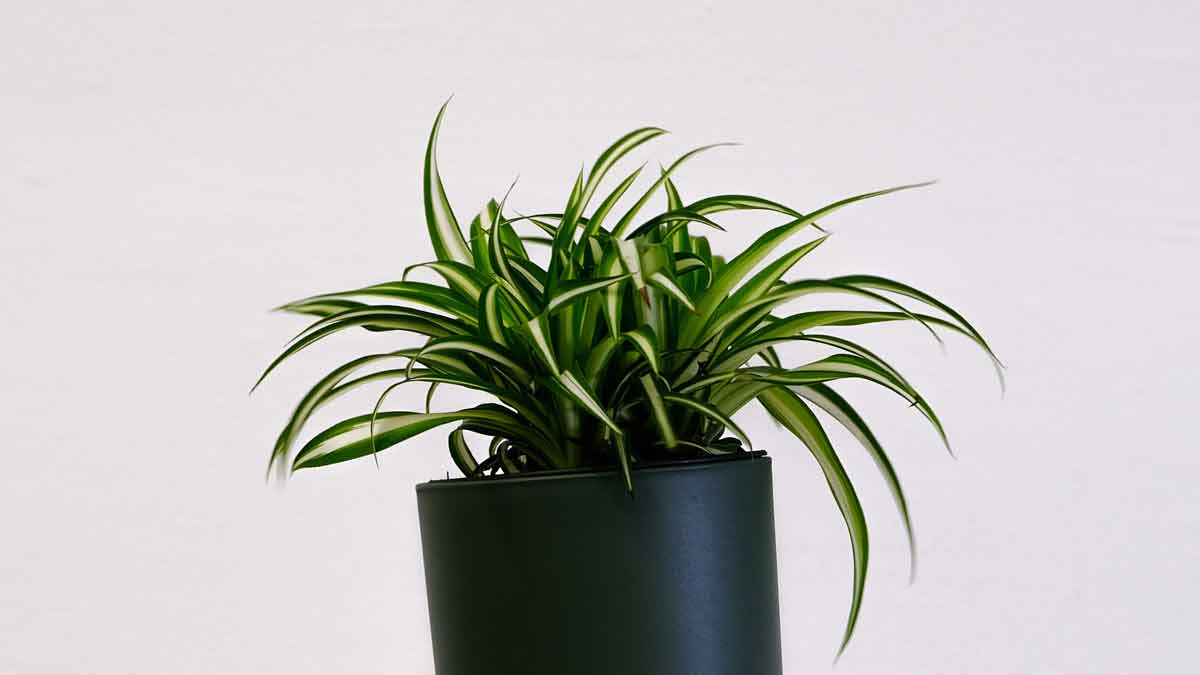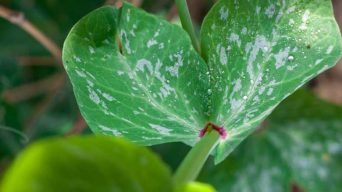Spider plants may wilt due to underwatering, overwatering, low humidity, excessive sunlight, or lack of light. Pests and diseases can also cause wilting. To prevent wilting, check soil moisture, ensure drainage, avoid direct sun, fertilize, prune, repot when needed, and watch for pests. Remove wilted leaves promptly. Proper care can help your spider plant recover.
Spider plant (Chlorophytum comosum) is a popular houseplant known for its easy care and ability to thrive in various conditions.
However, even the most resilient plants can experience problems from time to time.
One common issue that spider plants may experience is wilting.
If your spider plant is wilting, it’s essential to determine the cause so that you can take the appropriate steps to revive your plant.
Here are 10 possible reasons why your spider plant is wilting and what you can do to fix the problem.
Why Is Your Spider Plant Wilting?
Wilting is the drooping or sagging of leaves due to water loss.
When a plant is wilting, the leaves will appear dry and papery.
Wilting can be caused by various factors, including environmental stressors, pests, and diseases.
Here are some of the most common reasons your spider plant may be wilting.
1. Underwatering
One of the most common reasons for spider plants wilting is underwatering.
Spider plants are drought tolerant and can survive periods without water.
However, they will still need to be watered regularly to stay healthy.
Spider plants need to be watered about once a week or when the soil is dry to the touch.
If you are not watering your spider plant enough, it will start to wilt to indicate that it needs more water.
How To Tell If Your Wilting Spider Plant Is Underwatered
There are a few telltale signs that your spider plant is being underwatered.
In addition to wilting, you might also see:
- Soil that is dry to the touch
- Brown or yellow leaves
- Drooping leaves
- Dry, brittle leaves
- Slow growth
How To Fix An Underwatered Spider Plant
If you think your spider plant is being underwatered, the first thing you need to do is water it.
Give your plant a good soaking, making sure that water flows through the drainage holes in the pot.
Let the soil dry out completely before watering again.
You may also need to adjust your watering schedule to water your spider plant more often.
In general, spider plants need to be watered about once a week.
2. Overwatering
While underwatering is the most common reason for spider plant wilting, overwatering can also be problematic.
Spider plants are susceptible to root rot, which occurs when the roots are exposed to too much water.
This can cause the plant to wilt and turn yellow or brown.
How To Tell If Your Wilting Spider Plant Is Overwatered
There are a few signs that your spider plant is being overwatered.
In addition to wilting, you might also see:
- Soil that is soggy or waterlogged
- Brown or yellow leaves
- Mushy or soft leaves
- Leaves that are falling off
- Slow growth
- Fungal growth on the soil surface
How To Fix An Overwatered Spider Plant
If you think your spider plant is being overwatered, you first must stop watering it.
Allow the soil to dry out completely before watering again.
Ensure that the pot has good drainage so water can flow through easily.
You may also need to check your plant’s roots to see if they are damaged.
If the roots are mushy or soft, they will need to be removed, and the plant will need to be replanted in fresh soil.
3. Low Humidity
Spider plants are native to tropical regions and prefer high humidity.
While they can tolerate lower humidity levels, they may start to wilt if the air is too dry.
A spider plant needs humidity levels of at least 50%.
How To Tell If Your Wilting Spider Plant Is Experiencing Low Humidity
There are a few signs that your spider plant is not getting enough humidity.
In addition to wilting, you might also see:
- Brown tips on the leaves
- Dry, brittle leaves
- Drooping leaves
- Slow growth
How To Fix A Spider Plant That Is Experiencing Low Humidity
You can do a few things to increase the humidity around your spider plant.
One of the easiest ways to do this is to mist the spider plant leaves with water daily.
You can also place your plant on a pebble tray, which is a tray filled with water and pebbles.
The water will evaporate and increase the humidity around your plant.
Grouping your plants can also help to increase the humidity, as the plants will release water vapor into the air.
4. Too Much Direct Sunlight
While spider plants need some sunlight to grow, they can be damaged by too much direct sunlight.
Spider plants need bright indirect light to thrive.
If they are exposed to too much direct sunlight, the leaves can start to turn brown and dry out.
How To Tell If Your Spider Plant Is Wilting From Too Much Direct Sunlight
There are a few signs that your spider plant is getting too much direct sunlight.
In addition to wilting, you might also see:
- Brown or yellow leaves
- Dry, brittle leaves
- Leaves that are falling off
- Burned or scorched leaves
How To Fix A Spider Plant That Is Getting Too Much Direct Sunlight
If you think your spider plant is getting too much direct sunlight, the best thing to do is move it to a shadier spot.
Indoor plants can be placed in a spot with bright indirect light, such as near a window. East- or west-facing windows provide the best light for indoor plants.
You can also use a sheer curtain to filter the light if you don’t have a spot with bright indirect sunlight.
Outdoor plants should be placed in a spot with partial shade, such as under a tree or porch.
5. Lack of Light
While spider plants can tolerate low light levels, they need some light to grow.
If your spider plant is not getting enough light, it will get leggy and start wilting.
Spider plants need at least four hours of bright indirect light daily to thrive.
How To Tell If Your Spider Plant is Not Getting Enough Light
There are a few signs that your spider plant is not getting enough light.
In addition to wilting, you might also see:
- Discolored leaves
- Slow growth
- Fewer leaves than usual
- Leaves that are smaller than normal
- Leggy growth
- Fewer flowers or no flowers
How To Fix A Spider Plant That Is Not Getting Enough Light
If your spider plant is not getting enough light, the best thing to do is move it to a spot that gets more light.
Indoor spider plants do best near a bright window. An East or west-facing window is ideal.
You can also try using grow lights to give your spider plant the light it needs to grow.
If your spider plant is outdoors, try moving it to a spot that gets more sunlight. Be sure to acclimate it slowly to the new location, so it doesn’t get too much sun all at once.
6. Overfertilization
While spider plants need some fertilizer to grow, they can be damaged by too much fertilizer.
If you fertilize your spider plant too often or with too much fertilizer, the leaves can start to turn brown and dry out.
This can eventually lead to wilting.
Spider plants must be fertilized about once a month during the growing season, from spring to fall.
They don’t need to be fertilized during the winter when they are dormant.
How To Tell If Your Spider Plant Is Wilting From Overfertilization
There are a few signs that your spider plant is being overfertilized.
In addition to wilting, you might also see:
- Leaves that are brown and dry
- Leaves that are yellow or have brown spots
- Leaves that are falling off
- Stunted growth
- Roots that are brown and mushy
How To Fix A Spider Plant That Is Being Overfertilized
If you think your spider plant is being overfertilized, the best thing to do is flush the soil with water.
To do this, water the plant thoroughly and then let the excess water drain out. This will help to remove some of the fertilizer from the soil.
You should also cut back on how often you fertilize your spider plant. Fertilize it once a month during the growing season instead of every week.
If the roots are damaged, you may also need to repot the plant in fresh potting soil.
7. Heat Stress
Spider plants can wilt from heat stress, mainly if they are not used to the heat.
If your spider plant is wilting in the heat, it is probably because the leaves are losing water faster than the roots can take it up.
Spider plants thrive in temperatures between 60 and 75 degrees Fahrenheit.
They can tolerate higher temperatures for short periods, but they will start to wilt if the temperature gets too high.
How To Tell If Your Spider Plant Is Wilting From Heat Stress
There are a few signs that your spider plant is wilting from heat stress.
In addition to wilting, you might also see:
- Leaves that are curled or drooping
- Leaves that are discolored or browning
- A general decline in growth
How To Fix A Spider Plant That Is Wilting From Heat Stress
If your spider plant is wilting from heat stress, the best thing to do is move it to a cooler location.
Find a spot for your plant with indirect sunlight and a temperature between 60 and 75 degrees Fahrenheit.
You can also try misting your plant with water to help it cool down.
Avoid putting your spider plant in direct sunlight or a hot, dry location.
Ensure that the plant has good airflow and is not in an area where the temperature fluctuates dramatically.
8. Cold Temperatures
While spider plants can tolerate some cold temperatures, they can be damaged by extreme cold.
If your spider plant is wilting in the cold, it is probably because the leaves are freezing.
When the leaves freeze, they lose water and start to wilt.
Spider plants can tolerate temperatures as low as 50 degrees Fahrenheit.
However, they will start to wilt below 60 degrees Fahrenheit.
How To Tell If Your Spider Plant Is Wilting From Cold Temperatures
There are a few signs that your spider plant is wilting from cold temperatures.
In addition to wilting, you might also see:
- Brown or yellow leaves
- Leaves that are curled up or drooping
- Slow growth
If the temperature gets low enough, the leaves can start to turn black and die.
How To Fix A Spider Plant That Is Wilting From Cold Temperatures
If your spider plant is wilting from cold temperatures, the best thing to do is move it to a warmer location.
Find a spot for your plant with a temperature above 60 degrees Fahrenheit.
Place the plant away from any drafts or cold air.
You can also try wrapping the pot in a blanket or placing it on a heat mat to keep it warm.
9. Pests
Pests can also cause spider plants to wilt.
Spider mites, mealybugs, and aphids are all common pests that attack spider plants.
These pests suck the sap out of the leaves, causing the leaves to wilt.
Spider mites are tiny spider-like creatures that are difficult to see with the naked eye.
They are usually red, brown, or black and spin webs on the plant’s leaves.
Mealybugs are tiny white insects that secrete a waxy substance. They often congregate in groups on the stems and leaves of the plant.
Aphids are tiny green or black insects that suck the sap out of the leaves. They can also cause the leaves to curl up or distort.
How To Tell If Your Spider Plant Is Wilting From Pests
There are a few signs that your spider plant is wilting from pests.
In addition to wilting, you might also see:
- Small insects on the leaves or stems
- Sticky honeydew on the leaves
- Yellow, distorted, or curled leaves
- Holes in the leaves
- Webbing on the leaves
How To Fix A Spider Plant That Is Wilting From Pests
If your spider plant is wilting from pests, you should first isolate the plant from other plants.
This will prevent the pests from spreading to other plants.
Next, you need to get rid of the pests.
You can do this by spraying the plant with water or using insecticidal soap.
To use insecticidal soap, mix 1 tablespoon of soap with 1 quart of water.
Spray the solution on the leaves and stems of the plant, making sure to get under the leaves.
Do this every few days until the pests are gone.
You can also try using neem oil, which is a natural pesticide.
To use neem oil, mix 1 teaspoon of oil with 1 quart of water.
Spray the solution on the leaves and stems of the plant, making sure to get under the leaves.
Do this every few days until the pests are gone.
10. Disease
Diseases can also cause spider plants to wilt.
The most common disease that affects spider plants is root rot.
Root rot is caused by a fungus attacking the plant’s roots.
The roots start to decay, and the plant has trouble absorbing water.
This can cause the leaves to wilt.
Other diseases that can cause spider plants to wilt include fungal leaf spot and bacterial blight.
How To Tell If Your Spider Plant Is Wilting From Disease
There are a few signs that your spider plant is wilting from disease.
In addition to wilting, you might also see:
- Yellowing or browning leaves
- Leaves that are falling off
- Mushy or soft roots
- A foul smell coming from the plant
- A white, powdery substance on the leaves (this is called powdery mildew)
How To Fix A Spider Plant That Is Wilting From a Disease
If your spider plant is wilting from a disease, you should first isolate the plant from other plants.
This will prevent the disease from spreading to other plants.
Trim off any affected leaves and dispose of them.
Do not put them in your compost bin.
Next, you need to treat the plant with a fungicide or bactericide.
You can find these products at your local garden center.
Follow the directions on the package and apply the product to the plant as directed.
Do this every week until the disease is gone.
You can also use a natural treatment, such as copper sulfate.
Mix 1 tablespoon of copper sulfate with 1 gallon of water to use copper sulfate.
Spray the solution on the leaves and stems of the plant, making sure to get under the leaves.
Do this every two weeks until the disease is gone.
How To Prevent Your Spider Plant From Wilting
To prevent your spider plant from wilting, you should:
- Check the soil moisture level. The number one reason why spider plants wilt is because the soil is too dry. Before you do anything else, make sure to check the moisture level of the soil. If it’s dry, water your plant immediately.
- Make sure your pot has drainage holes. If your pot doesn’t have drainage holes, water will just sit on the bottom and cause the roots to rot. Make sure to get a pot with drainage holes or drill some yourself.
- Don’t water too often. While you need to keep the soil moist, you don’t want to water it too often. Watering too often will also cause the roots to rot-only water when the soil is dry.
- Avoid direct sunlight. Spider plants do best in indirect sunlight. If you live in a hot climate, make sure to put your spider plant in a spot where it won’t get direct sun.
- Fertilize your plant. Spider plants need to be fertilized about once a month. You can use any type of liquid fertilizer or slow-release pellets.
- Prune your plant. If your spider plant is getting too big, you can prune it to keep it under control. Just make sure to use sharp, clean shears.
- Repot your plant. If your spider plant is getting too big for its pot, you’ll need to repot it. Choose a pot that’s only a few inches bigger than the current one.
- Check for pests. Spider plants are susceptible to mealybugs, aphids, and spider mites. If you see any of these pests on your plant, you’ll need to treat it immediately.
- Bring your plant inside. If the weather outside is getting too cold, you’ll need to bring your spider plant inside. Spider plants can’t tolerate freezing temperatures.
- Get rid of wilted leaves. If you see any wilted leaves on your spider plant, you should remove them immediately. To do this, just cut the leaves off at the base of the plant.
If you follow these tips, you should be able to prevent your spider plant from wilting. Check on your plant regularly and take action if you see any problems.
Final Thoughts
If your spider plant is wilting, it’s essential to figure out the cause so that you can take steps to fix the problem.
Sometimes, wilting is simply due to a lack of water. However, it can also be caused by pests, diseases, or too much water.
Once you’ve determined the cause of the problem, you can take steps to fix it.
In most cases, proper care and attention will help your spider plant recover from wilting.
Just keep an eye on it and take action as soon as you notice any problems.







